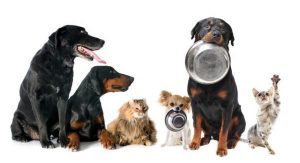The ideal weight for a domestic cat is about 8-10 pounds. Some breeds, like the Maine Coon, can top out at about 15 pounds, while Siamese cats may weigh as little as 5 pounds. In striking contrast to these figures, the majority of pet cats in our country are considered overweight or obese.
The best way to counter the health ramifications associated with too many pounds? Prevention, of course! Staying in front of feline obesity is an enormous responsibility, and we’re here to help our patients live their longest, healthiest life possible.
Proper Nutrition (and Exercise!)
When cats are young, they burn up a lot of calories by playing, pouncing, and simply growing. But their nutritional needs change when they reach adulthood. No longer in need of extra food to supplement speedy development, portion sizes should level out around a cat’s first birthday.
Measured meals, restricted treats, and lots of daily exercise can all maintain a cat’s ideal weight far into their life. A daily game of chase with a laser pointer or a feather toy can add a great deal of mental and physical enrichment to an indoor-only cat’s lifestyle.
All Stages
Senior cats tend to slip into routines of sleeping, eating, and grooming. As a result, over 55% of cats over the age of 7 are at risk of developing chronic problems that are associated with extra weight gain, such as respiratory illnesses, diabetes and arthritis.
Even just a few extra pounds on a cat is equivalent to 30-50 pounds on a person. Added weight can be difficult to reduce, and as cats age, the problems caused by their weight become more pronounced. Not surprisingly, treatment for various health problems can become complicated as they age.
Preventing Feline Obesity
Keeping your cat active and fit should remain a top priority. Equally important is feeding them the right amount of food every day. We know that some cats beg for treats or snacks between meals, and it feels great to make them happy. However, it’s easier to keep the pounds off to begin with rather than trying to lose excess weight down the line.
A Word on Diabetes
Feline obesity is a risk factor for diabetes, and it can make this preventable disease more difficult to control.
Here to Help
A big part of your cat’s routine wellness exam is recording their weight. If we’ve known your cat since kittenhood, we have tracked any changes to the weight, body condition score, and appearance. We always encourage cat owners to maintain wellness care appointments so that we may prevent any developing problems, and treat conditions before they get out of hand.
Hidden Dangers
We know well the negative impact of feline obesity because joint pain is fairly obvious to observe. However, inflammation caused by fat tissue can spread throughout the body and cause other illnesses that we cannot see.
Similarly, feline obesity can make anesthesia more dangerous, increasing the need for additional medical care, and require certain medications.
If you have further questions about preventing feline obesity, or have concerns about maintaining lifelong health, please let us know. Cat Care of Vinings is always here to help you!







